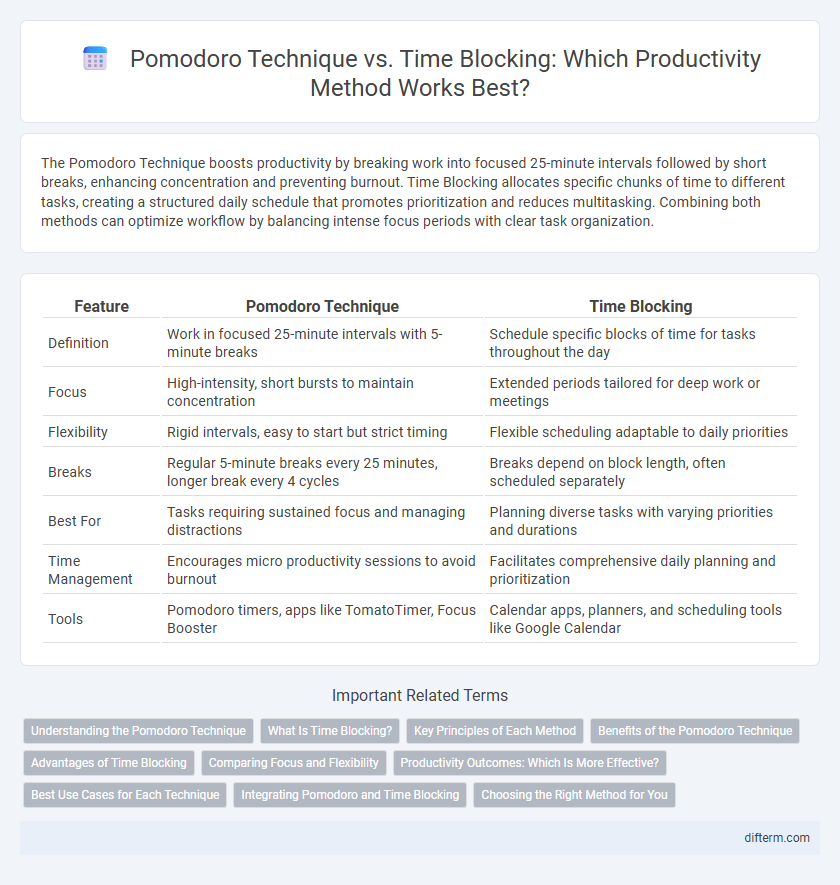The Pomodoro Technique boosts productivity by breaking work into focused 25-minute intervals followed by short breaks, enhancing concentration and preventing burnout. Time Blocking allocates specific chunks of time to different tasks, creating a structured daily schedule that promotes prioritization and reduces multitasking. Combining both methods can optimize workflow by balancing intense focus periods with clear task organization.
Table of Comparison
| Feature | Pomodoro Technique | Time Blocking |
|---|---|---|
| Definition | Work in focused 25-minute intervals with 5-minute breaks | Schedule specific blocks of time for tasks throughout the day |
| Focus | High-intensity, short bursts to maintain concentration | Extended periods tailored for deep work or meetings |
| Flexibility | Rigid intervals, easy to start but strict timing | Flexible scheduling adaptable to daily priorities |
| Breaks | Regular 5-minute breaks every 25 minutes, longer break every 4 cycles | Breaks depend on block length, often scheduled separately |
| Best For | Tasks requiring sustained focus and managing distractions | Planning diverse tasks with varying priorities and durations |
| Time Management | Encourages micro productivity sessions to avoid burnout | Facilitates comprehensive daily planning and prioritization |
| Tools | Pomodoro timers, apps like TomatoTimer, Focus Booster | Calendar apps, planners, and scheduling tools like Google Calendar |
Understanding the Pomodoro Technique
The Pomodoro Technique enhances productivity by breaking work into focused 25-minute intervals called "Pomodoros," separated by short breaks, optimizing concentration and minimizing burnout. This time management method leverages a simple kitchen timer to create urgency and maintain consistent work rhythm, ideal for tasks requiring sustained attention. Compared to Time Blocking, which allocates larger chunks of time for diverse activities, the Pomodoro Technique provides granular focus and frequent rest cycles to sustain high mental energy throughout the day.
What Is Time Blocking?
Time blocking is a productivity method that involves scheduling specific blocks of time for distinct tasks or activities, enhancing focus and reducing multitasking. By assigning time intervals to particular work segments, it helps manage workload more effectively and maintains a structured daily plan. Unlike the Pomodoro Technique, which uses fixed short breaks, time blocking allows customized periods tailored to the complexity and priority of each task.
Key Principles of Each Method
The Pomodoro Technique centers on working in focused 25-minute intervals followed by short breaks, enhancing concentration and preventing burnout through consistent time separation. Time Blocking involves scheduling specific time slots for different tasks or activities throughout the day, ensuring dedicated attention and better task prioritization. Both methods optimize productivity by structuring work periods but differ in flexibility and focus management.
Benefits of the Pomodoro Technique
The Pomodoro Technique enhances focus by breaking work into 25-minute intervals, minimizing distractions and preventing burnout. This method promotes sustained productivity through regular short breaks, which help maintain mental clarity and reduce fatigue. Users experience improved time management and heightened motivation by tracking completed Pomodoros, leading to efficient task completion and greater overall output.
Advantages of Time Blocking
Time Blocking enhances productivity by allocating specific time periods for individual tasks, reducing decision fatigue and encouraging deeper focus. It allows for better workload management and prevents task overlap, leading to increased efficiency and effective time utilization. Unlike the Pomodoro Technique's fixed intervals, Time Blocking offers flexibility to adjust durations based on task complexity.
Comparing Focus and Flexibility
The Pomodoro Technique enhances focus by breaking work into fixed 25-minute intervals separated by short breaks, minimizing distractions and maintaining high concentration levels. Time Blocking offers greater flexibility by allocating specific time slots for different tasks throughout the day, allowing adjustments based on priorities or interruptions. This balance between structured focus and adaptable scheduling supports diverse productivity needs depending on individual work styles.
Productivity Outcomes: Which Is More Effective?
The Pomodoro Technique enhances productivity by breaking work into focused 25-minute intervals with short breaks, boosting concentration and reducing burnout. Time Blocking improves productivity through structured scheduling of tasks, allowing for deep work periods and better time management. Studies show Pomodoro suits tasks requiring frequent mental resets, while Time Blocking is more effective for complex projects demanding extended focus, making the choice dependent on individual work style and task nature.
Best Use Cases for Each Technique
Pomodoro Technique excels in tasks requiring intense focus and frequent breaks, ideal for avoiding burnout during repetitive or creative work sessions. Time Blocking suits complex schedules, enabling segregation of diverse activities, meetings, and personal tasks into dedicated time slots for enhanced overall productivity. Combining both methods can optimize workflow by balancing focused work intervals with structured daily planning.
Integrating Pomodoro and Time Blocking
Combining Pomodoro Technique and Time Blocking enhances productivity by structuring work periods with precise time blocks and incorporating focused 25-minute Pomodoro sprints within those intervals. This integration leverages the Time Blocking method's macro scheduling for task allocation alongside Pomodoro's micro-level focus and regular breaks, reducing burnout and maintaining high concentration. Adopting both techniques in tandem allows for balanced workload management and sustained mental clarity throughout the workday.
Choosing the Right Method for You
Choosing between the Pomodoro Technique and Time Blocking depends on your work style and task complexity. Pomodoro offers structured intervals with short breaks, ideal for maintaining focus during repetitive or short tasks, while Time Blocking allocates larger, dedicated time segments suitable for deep work and multitasking. Evaluating your productivity patterns and task demands helps determine the optimal method to boost efficiency and reduce burnout.
Pomodoro Technique vs Time Blocking Infographic

 difterm.com
difterm.com